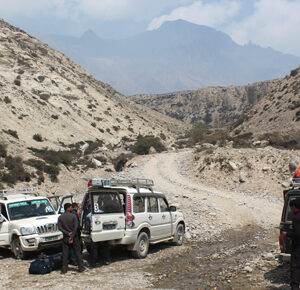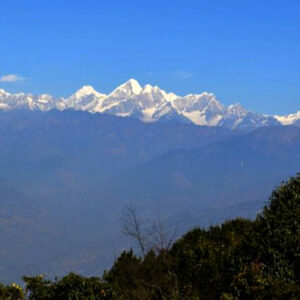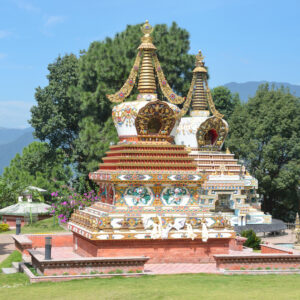DAY 1 FLY KATHMANDU – LHASA, DRIVE TO TSEDANG
Upon arrival at Gongar Airport, meet and drive to Tsedang (1.5 hrs).
Tsedang sits on the south bank in the middle section of the Yarlung Tsangpo River with a moderate climate at an altitude of 3,600 meters. Tsedang is the birthplace of earliest Tibetans who were said to be the offspring of a monkey and a demoness, so Tsedang literally means “monkey’s playground”.
Rest of the afternoon at leisure to acclimatize.
Overnight at hotel in Lhasa
DAY 2 VISIT YUMBULAKHANG & SAMYE MONASTERY, DRIVE TO LHASA
After breakfast, visit Yumbulakhang and Samye Monastery.
Samye was the first Buddhist monastery to be founded in Tibet. It is also notable as the site of the “Great Debate” (792-794) between the Indian Mahayanists and Chinese Chán (Zen) Buddhists. Samye is famous for its sacred mandala design: the central temple symbolizes the legendary Mount Meru, center of the universe. It is a popular pilgrimage destination for Tibetan Buddhists, some of whom travel on foot for weeks to reach it.
Continue drive to Lhasa for the night.
Overnight at Hotel
DAY 3 VISIT POTALA PALACE, DREPUNG AND NORBULINGKHA
You will be engrossed with full day sightseeing tour to Potala Palace, Drepung & Norbulinka Monastery.
Potala Palace: The Potala, one of the most famous architectural works of the world, sits on top of the Red Hill in Lhasa. In the 7th century, after the Tibetan King Songtsen Gampo’s married Princess Wencheng of the Tang Court, the Palace was built to provide the Tibetan court with a place of worship and meditation. In the mid-17th century, it was re-built by the 5th Dalai Lama to its present size, and became the Winter Palace of the Dalai Lamas.
Drepung Monastery: Situated at the foot of the Mountain Gambo Utse, 5 kilometers from the western suburb of Lhasa, the Drepung Monastery is known as the most important monastery of Gelugpa in Tibetan Buddhism. It is considered one of the ‘Three Great Monasteries’ (the other two are the Ganden Monastery and the Sera Monastery. Covering an area of 250,000 square meters, it held 7,700 monks in total and possessed 141 fazendas and 540 pastures in its heyday, and is the largest-scale monastery among the ones of the same kind. Seen from afar, its grand, white construction gives the monastery the appearance of a heap of rice. As such, it was given the name ‘Drepung Monastery’ which, in the Tibetan language, means Monastery of Collecting-Rice
Norbulingkha: Summer Palace of the Dalai Lamas is a short distance away in the western part of town; and in Lhasa’s low-lying surrounding hills are the important Gelungpa monasteries of Sera and Drepung. In the palace there are many splendid murals painted by a Fourteenth Dalai Lama’s painter. The topics of the murals are vast, including: Tibetan officials, Sakyamuni preaching under a Bodhi tree, Tibetan history.
Overnight at hotel in Lhasa
DAY 4 VISIT SERA MONASTERY, JOKHANG TEMPLE & BARKHOR MARKET
After breakfast, visit the below places.
Sera Monastery: Sera is one of the ‘great three’ Gelukpa university monasteries of Tibet. The original monastery was in Lhasa, Tibet, about 5 km north of the Jokang. Sera was founded in 1419, by Jamchen Chojey (Sakya Yeshe), a disciple of Tsong Khapa. It is housed for more than 5,000 monks in 1959. Although badly damaged, it is still standing and has been largely repaired. It now houses a few hundred Buddhist monks. After the Chinese invasion of Tibet and the destruction of the majority of the monasteries in Tibet, Sera monastery was reformed in Bylakuppe, India, near Mysore. Because none of the monks of the Ngagpa Dratsang (Tantric College) survived the invasion, only the Sera Mey College and Sera Jey College were reformed in India. under a Bodhi tree, Tibetan history.
Jokhang Temple: Jokhang Temple, situated in the center of the old section of Lhasa called Barkhor, was built in the mid-7th century A. D. It was later extended by successive rulers, and has now become a gigantic architecture complex. Located in the east, and facing the west, Jokhang is a four storied Temple with splendid golden roofs. Its architecture features art from the Tang Dynasty but also assimilated many features from both Nepalese and Indian Buddhist Temples. The murals in the temple depict the life stories of historic and religious characters. The temple houses many historical relics, including statues of King Songtsen Gompo, Princess Wencheng, Princess Bhrikuti Devi (Nepalese), “Princess Willow” (a tree) and “The Uncle-Nephew Alliance Tablet.” Jokhang is Tibet’s spiritual center, and the holiest destination for Tibetan Buddhist pilgrims. It houses a sitting of statue of Shakyamuni when he was 12 years old. The circular Barkhor Street has innumerable shops, and wayside peddlers intermingle with devotees walking clockwise around the Jokhang. An evening walk (Kora) around the Jokhang Temple together with the Tibetan pilgrims is a lifetime experience.
Barkhor Market: Walk along the Barkhor street that circles the Jolkhan and you are in the heart of the old Lhasa with its narrow streets white- washed stone homes, window framed in black and brightly painted woodwork and almost everyone has got something to sell over there. T surphu (Tuling Churba Gompa), lies northwest of Lhasa, just off the main Lhasa.
Overnight at hotel in Lhasa
DAY 5 LHASA – GYANTSE (3,950 m) – SHIGATSE (3,900 m)
Today you will be transferred from Lhasa to Gyantse (5 – 6 hours). En route, you’ll stop to see Yamdrok Lake, one of three most famous holy lakes in Tibet. For Tibetans, it is one of the four holy lakes of Tibet and the home of the “wrathful deities”. The scenery of turquoise blue water in the lake with the reflection of surrounding snow-capped mountains is awesome.
Yamdrok Lake: Stop at Lake Yamdrok Tso, also known as the Scorpion Lake for its unique shape. One of the four holy lakes of Tibet, Yamdrok Tso covers a staggering 230 square miles and lies at nearly 15,000 feet above sea level. Rife with aquatic life, dotted with islets, and surrounded by fields of wildflowers, Yamdrok Tso is not only naturally stunning but an important place of pilgrimage; its waters are believed to hold powers of rejuvenation and longevity, and to bless children with intelligence. Its small islands are home to roosting birds and, during the herding season, to flocks of sheep, ferried there by herders who leave them in peace and safety until the onset of winter. Pilgrims often wander the lake’s shores, making their way along kora paths, many of which take a week to complete.
Gyantse: Gyantse is one of the most authentic towns in Tibet, and little-touched by Chinese influences. In the twentieth century, Gyantse, due to its location, was the site of a series of bloody battles between invading British forces and the Tibetan defenders; later, the town suffered serious devastation during the Cultural Revolution, when monks were persecuted and the prominent Pelkor Chode Monastery was damaged.
Despite the turmoil it has faced, however, Gyantse today has retained much of its Tibetan heritage, and has recently gained attention from curious travelers seeking to experience Tibet at its most authentic.
Later continuing drive to Shigatse (1 – 1.5 hours) after visiting a large fort overlooking the town; and the Pelkor Chode Monastery.
Shigatse is the capital of the central Tsang region, and Tibet’s largest city. Long a political rival to Lhasa, Shigatse is the seat of the Panchen Lamas, the second-highest lamas in Tibet, after the Dalai Lama. Like Lhasa, Shigatse has an old town, with a range of rambling alleys, compounds, and monasteries, as well as a newer, more modern enclave.
Evening visit to a lively local market to experience the distinctive local life.
Overnight at hotel in Shigatse
DAY 6 SHIGATSE – LHASA
After breakfast, Visit the Tashilunpo Monastery, home to the Panchen Lama, a ranking spiritual figure second only to the Dalai Lama in importance. Founded in 1447, the monastery is a large compound of chapels, courtyards, and byways. Within the monastery is a tall, 75-foot (23 meter) statue of the Maitreya Buddha, finished with gold leaf, as well as a population of resident monks. Like the Potala in Lhasa, Tashilunpo houses several impressive funeral chapels for the Panchen Lamas, including that of the 10th, who passed away in 1989 and whose chorten, or stupa, cost an estimated $8 million to build.
Later today you’ll be driven back to Lhasa (5 – 6 hours) along the legendary Yaluzangbu River, the mother river of Tibet. Along the journey, you will view fantastic landscape of the valley and snow mountain, and get the special feeling of travelling in the wilderness, far from modern civilization.
Overnight at hotel in Lhasa
DAY 7 FLY LHASA – KATHMANDU
Transfer to airport on time for flight back to Kathmandu.
Rest of the day at leisure.
Overnight at hotel in Kathmandu








Reviews
There are no reviews yet.